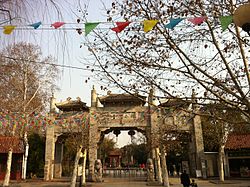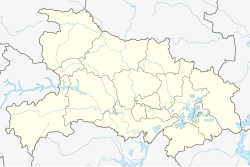Qingshan District (simplified Chinese: 青山区; traditional Chinese: 青山區; pinyin: Qīngshān Qū; lit. 'azure mountain') forms part of the urban core of and is one of 13 urban districts of the prefecture-level city of Wuhan, the capital of Hubei Province, China. On the right bank of the Yangtze, it borders the districts of Wuchang (for a very small section) to the southwest and Hongshan to the east and south, except for Tianxing Island which lies due north of Qingshan; on the opposite bank it borders Jiang'an.
Qingshan
青山区 | ||||||||||||||||||||||||||||||||||||
|---|---|---|---|---|---|---|---|---|---|---|---|---|---|---|---|---|---|---|---|---|---|---|---|---|---|---|---|---|---|---|---|---|---|---|---|---|
 Qingshan Park Main Gate | ||||||||||||||||||||||||||||||||||||
 | ||||||||||||||||||||||||||||||||||||
| Coordinates: 30°37′51″N 114°24′17″E / 30.6307°N 114.4046°E[1] | ||||||||||||||||||||||||||||||||||||
| Country | People's Republic of China | |||||||||||||||||||||||||||||||||||
| Province | Hubei | |||||||||||||||||||||||||||||||||||
| Sub-provincial city | Wuhan | |||||||||||||||||||||||||||||||||||
| Area | ||||||||||||||||||||||||||||||||||||
| • Total | 68.40 km2 (26.41 sq mi) | |||||||||||||||||||||||||||||||||||
| Population (2010)[3] | ||||||||||||||||||||||||||||||||||||
| • Total | 485,375 | |||||||||||||||||||||||||||||||||||
| • Density | 7,096/km2 (18,380/sq mi) | |||||||||||||||||||||||||||||||||||
| Time zone | UTC+8 (China Standard) | |||||||||||||||||||||||||||||||||||
| Wuhan district map |
| |||||||||||||||||||||||||||||||||||
| Website | Official Site | |||||||||||||||||||||||||||||||||||
Qingshan District has been described as Wuhan's industrial hub.[4]
Geography
editAdministrative divisions
editAs of 2015, Qingshan District administers ten subdistricts, one administrative committee and one economic development zone:[5][6]
| Location Name | Chinese (S) | Hanyu Pinyin |
|---|---|---|
| Honggangcheng Subdistrict | 红钢城街道 | Hónggāngchéng Jiēdào |
| Xingouqiao Subdistrict | 新沟桥街道 | Xīngōuqiáo Jiēdào |
| Hongweilu Subdistrict | 红卫路街道 | Hóngwèilù Jiēdào |
| Yejin Subdistrict | 冶金街道 | Yějīn Jiēdào |
| Ganghuacun Subdistrict | 钢花村街道 | Gānghuācūn Jiēdào |
| Gongrencun Subdistrict | 工人村街道 | Gōngréncūn Jiēdào |
| Qingshanzhen Subdistrict | 青山镇街道 | Qīngshānzhèn Jiēdào |
| Changqian Subdistrict | 厂前街道 | Chǎngqián Jiēdào |
| Wudong Subdistrict | 武东街道 | Wǔdōng Jiēdào |
| Baiyushan Subdistrict | 白玉山街道 | Báiyùshān Jiēdào |
| Gangduhuayuan Administrative Committee | 钢都花园管委会 | Gāngdūhuāyuán[7] Guǎnwěihuì |
| Qingshan District Economic Development Zone | 青山区经济开发区(北湖园区) | Qīngshān Qū Jīngjì Kāifāqū (Běihúyuán Qū) |
Economy
editQingshan District has been described as Wuhan's industrial hub, it is home to Qingshan shipyard of China Changjiang National Shipping (Group) Corporation and a factory of the Wuhan Iron and Steel Corporation.[4] Its eight 'pillar industries' are metallurgy, chemical manufacture, environmental protection, electric power, machinery, shipping, construction, and building materials.[8]
Environment
editDue to its history as an industrial base, the district is considered severely polluted with heavy metals.[8][9] The local air quality has been improved in recent years but is still considered to exceed acceptable levels and is among the worst of Wuhan's districts.[10][11]
The district is a demo area of the sponge city concept to reduce flooding.[12][13]
References
edit- ^ "Qingshan" (Map). Google Maps. Retrieved 2014-07-02.
- ^ "Wuhan Statistical Yearbook 2010" (PDF). Wuhan Statistics Bureau. p. 15. Archived from the original (PDF) on November 5, 2011. Retrieved 2011-07-31.
- ^ "武汉市2010年第六次全国人口普查主要数据公报" (in Chinese). Wuhan Statistics Bureau. 2011-05-11. Archived from the original on 2011-10-25. Retrieved 2011-06-11.
- ^ a b "Riverfront industrial town transformed into eco-city-Xinhua". english.news.cn. Retrieved 2024-08-07.
- ^ 行政区划 (in Simplified Chinese). Qingshan District People's Government. 14 December 2016. Retrieved 16 December 2017.
2015年,青山区辖10个行政街道、1个管理委员会、1个经济开发区,{...}1个管理委员会是钢都花园{...}红钢城街道{...}新沟桥街道{...}红卫路街道{...}冶金街道{...}钢花村街道{...}工人村街道{...}青山镇街道{...}厂前街道{...}武东街道{...}白玉山街道{...}钢都管委会{...}青山区经济开发区(北湖园区办){...}
[permanent dead link] - ^ 青山区历史沿革 [Historical Development of Qingshan District] (in Simplified Chinese). XZQH.org. 7 July 2014. Retrieved 16 December 2017.
2010年第六次人口普查,青山区常住总人口485607人,其中:红卫路街道82337人,冶金街道78887人,新沟桥街道54932人,红钢城街道37992人,工人村街道14141人,青山镇街道20791人,厂前街道9961人,武东街道25254人,白玉山街道37703人,钢花村街道77222人,武钢厂区281人,钢都花园管委会39919人,北湖管委会6187人。
- ^ 《汉语拼音正词法基本规则》6.2.2.3条.2012, pp.8 Words that have become proper nouns in the name of a Han Chinese location name are written without any spaces.
- ^ a b Chen, Hong; Zhan, Changlin; Liu, Shan; Zhang, Jiaquan; Liu, Hongxia; Liu, Ziguo; Liu, Ting; Liu, Xianli; Xiao, Wensheng (January 2022). "Pollution Characteristics and Human Health Risk Assessment of Heavy Metals in Street Dust from a Typical Industrial Zone in Wuhan City, Central China". International Journal of Environmental Research and Public Health. 19 (17): 10970. doi:10.3390/ijerph191710970. ISSN 1660-4601. PMC 9518381. PMID 36078702.
- ^ Yang, Yong; Mei, Yang; Zhang, Chutian; Zhang, Ruoxi; Liao, Xiangshen; Liu, Yinyin (2016-01-02). "Heavy metal contamination in surface soils of the industrial district of Wuhan, China". Human and Ecological Risk Assessment: An International Journal. 22 (1): 126–140. Bibcode:2016HERA...22..126Y. doi:10.1080/10807039.2015.1056291. ISSN 1080-7039.
- ^ Wang, Jing; Mao, Xiang; Fan, Chuangang; Liu, Shuaxia; He, Zuan (2020). "Composition characteristics and chronic health risk assessment of atmospheric PM2.5 pollution in Qingshan District of Wuhan". Journal of Public Health and Preventive Medicine (in Chinese): 94–98.
- ^ Chen, Guici; Zhang, Zuo; Zuo, Qian (2020-06-01). "Air Quality Analysis of Wuhan from the Perspective of Functional Data". IOP Conference Series: Earth and Environmental Science. 526 (1): 012029. Bibcode:2020E&ES..526a2029C. doi:10.1088/1755-1315/526/1/012029. ISSN 1755-1307.
- ^ "Building Climate Resilience And Water Security In Cities: Lessons From The Sponge City Of Wuhan, China" (PDF). Coalition for Urban Transition.
- ^ Schlossberg, Tatiana (2022-03-28). "Turning Cities Into Sponges to Save Lives and Property". The New York Times. ISSN 0362-4331. Retrieved 2024-08-07.

